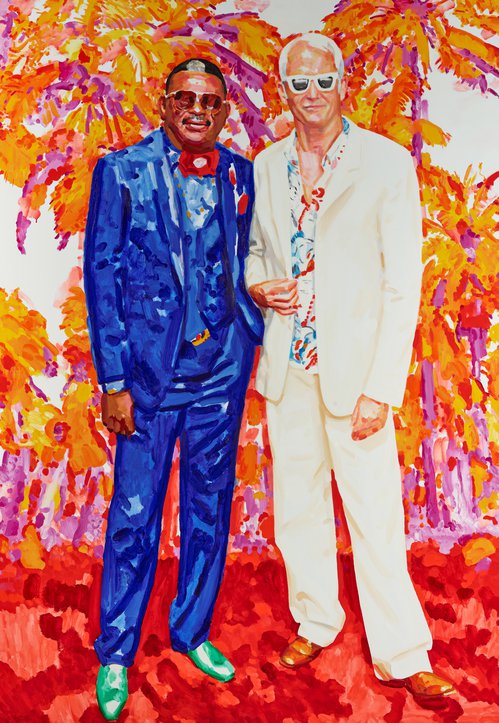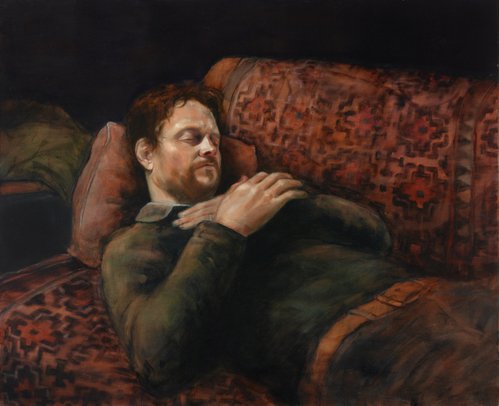
To be fair, art is a very subjective subject. As Yotam Ottolenghi once said: ‘one man’s trash is another man’s treasure’. After the controversy that dogged of the winner of the Archibald prize last year, it was hardly surprising that the board of trustees was keen to avoid yet another public relations brouhaha. Perhaps it was purely coincidental – but it sure was nicely timed.
After seven years of drawing centenarians, Melbourne’s Peter Wegner painted the portrait of 100-year-old fellow artist Guy Warren AM – and claimed the Archibald Prize on the art gong’s 100th anniversary.
Mr Wegner’s Portrait of Guy Warren at 100 depicts Mr Warren sitting in a wooden chair wearing white clothes and draped in a pink jumper.
Mr Warren, the 1985 Archibald Prize winner, was born in April 1921 – the same year that the Archibald Prize was first awarded in Australia.
Critics said the portrait was a “moving insight” into Mr Warren’s state of mind as he enters his 11th decade, accentuating his pride and sense of purpose.
Art Gallery of NSW board president David Gonski said Mr Wegner was unanimously chosen by the panellists for the top gong.
Mr Wegner – a previous five-time Archibald Prize finalist – said on Friday that Mr Warren’s triple-figured age was not intentional but “nicely timed”.
He said he took inspiration from Mr Warren’s continued work in the art studio and counted him among the most extraordinary centenarians he had painted.
The centenarian artist, who lives in the lower north shore Sydney suburb of Greenwich, said he had never met the Melbourne-based Wegner until he was approached to sit for the portrait.
“I’d like to know the guy better because he’s obviously got an enormous amount of talent,” he said.
“It’s a bloody good painting … it’s in the full tradition of good portrait painting and that tradition goes back a hell of a long way.
“Secondly, it is a very good likeness. And thirdly, I’m told, it says something about my character, but I’m not the one to be the judge of that, I don’t know.”
Mr Wegner has painted more than 90 centenarians so far.
“My wife burst into tears, and I was speechless … this is an unbelievable moment in my life,” he said after the award ceremony.
“It’s the culmination of years of time in the studio, and validation of my work.”
Mr Wegner will take home $100,000 as part of the prize win.
The Archibald was the first major prize for portraiture in Australian art. It was first awarded in 1921 after the receipt of a bequest from J.F. Archibald (1856-1919), a journalist and founder of the Bulletin Magazine. He also served as a Trustee of the Art Gallery of NSW.
Yet Archibald had no desire to become famous and during his lifetime shunned publicity and remained evasive and enigmatic.
When he died in 1919, leaving one tenth of his estate of £89,061 in trust for a non-acquisitive annual art prize to be awarded by the Trustees of the (then) National Art Gallery of New South Wales (now Art Gallery of New South Wales). In today’s money that made the value of his bequest approximately $251,798.00 per year.
 JF Archibald
JF Archibald
According to the terms of the will of the late JF Archibald; dated 15 March 1916, the bequest of the prize was to be awarded to: ‘the best portrait preferentially of some man or woman distinguished in art, letters, science, or politics, painted by any artist resident in Australasia during the 12 months preceding the date fixed by the Trustees for sending in the picture were. Additionally, ‘portraits should be as far as practicable painted from life and may be of any size. No direct copies from photographs will be considered eligible’. The primary aim was to ‘foster portraiture, as well as support artists and perpetuate the memory of great Australians’.
Accepting that historically the Archibald Prize has not been without controversy — in 1943 when William Dobell won the award for his entry of Joshua Smith. Two other entrants were so incensed they took legal action in the supreme Court of NSW. The challenge was based on the grounds that the painting was not a portrait as defined by the Archibald Bequest. The case was dismissed, and the court ordered the claimants to pay costs for Dobell and the Trustees.

Portrait of Tim Burstall
In 1975 John Bloomfield’s portrait of Tim Burstall, painted from a blown-up photograph, was disqualified on the grounds that the portrait had to be painted from life. The prize was rejudged and awarded to Kevin Connor.
Then again in 1985 they were back in court. The Perpetual Trustee Company, which administered Archibald’s will, took the Australian Journalists Association Benevolent Fund to court. The AJA was named as first defendant in the case because it stood to inherit the money if the Archibald Prize failed to fulfil the criteria that the prize was still a ‘good charitable bequest’. The Court found that the Archibald Prize did fulfil this and directed that the Perpetual Trustees Company should transfer administration of the Trust to the Art Gallery of NSW.
In 1997 the painting of the Bananas in Pyjamas television characters by Evert Ploeg was not allowed because it was not a painting of a person.
Hundreds of portraits each year are not accepted as finalists.
The 2000 Archibald winner, Adam Cullen, took action against the American Broadcasting Company who had used his painting, ‘Portrait of David Wenham’, in a television commercial.
In 2002, head packer Steve Peters chose a painting of himself by Dave Machin as a possible winner for the Packing Room Prize. It did not win, but it was on display outside the Archibald exhibition. After this, portraits of the head packer were no longer allowed.
In 2004 Craig Rudd’s portrait of actor Davis Gulpilil, won both the main prize and the “People’s Choice” award. It was challenged because it was a charcoal sketch rather than a painting. The claim was dismissed in the Supreme Court in June 2006.
In 2008 Sam Leach’s portrait of himself as Adolf Hitler made the front page of Melbourne’s newspaper The Age. This started a national argument about of his choice of subject matter.
The Archibald is one of the few art prizes in which the artist’s signature is covered up. The judges do not know who did the paintings. This is to try and stop the judges, some of whom are artists, from simply giving the prize to their friends and not the best painting.

1938 Nora Heysen the first woman to win the Archibald Prize with her portrait of Madame Elink Schuurman,
This year there were 938 entries with (52 selected to be hung)
For the first time, there was a gender parity for artists selected as Archibald finalists: 26 women and 26 men. Female sitters outnumber the men (although that is not a first).
It is also the first time there have been more works by women than men in the combined Archibald, Wynne, and Sulman Prizes exhibition.
The 52 works selected were: (for more information of the individual entries click onto the link at the bottom of each entry and you will be taken to the NSW Art Galley site)
 Peter Berner Stop pouting, you’ve had your turn
Peter Berner Stop pouting, you’ve had your turn
 Karen Black Professor Chandini Raina Macintyre
Karen Black Professor Chandini Raina Macintyre
 Tom Carment Mara reading, in the kitchen at Mount Lofty
Tom Carment Mara reading, in the kitchen at Mount Lofty
 Matthew Clarke Del Kathryn Barton is a good listener
Matthew Clarke Del Kathryn Barton is a good listener
 Jonathan Dalton Ramesh and the artist Ramesh
Jonathan Dalton Ramesh and the artist Ramesh
 Tsering Hannaford Her Excellency the Honourable Margaret Beazley AC QC
Tsering Hannaford Her Excellency the Honourable Margaret Beazley AC QC
 Dapeng Liu A mind–body dualism portrait of Joanna Capon
Dapeng Liu A mind–body dualism portrait of Joanna Capon
 Mathew Lynn Apprentice – self-portrait with Papa K (aka I do see colour)
Mathew Lynn Apprentice – self-portrait with Papa K (aka I do see colour)
 Sally M Nangala Mulda Two town camp stories
Sally M Nangala Mulda Two town camp stories
 James Powditch Kerry O’Brien – all along the watch tower
James Powditch Kerry O’Brien – all along the watch tower
 Joan Ross Joan as a colonial woman looking at the future
Joan Ross Joan as a colonial woman looking at the future
 Kirthana Selvaraj The green suit, a self-portrait
Kirthana Selvaraj The green suit, a self-portrait
 Oliver Watts Dorian Gray (Eryn Jean Norvill)
Oliver Watts Dorian Gray (Eryn Jean Norvill)
Eunice Djerrkŋu Yunupiŋu Me and my sisters
 Julianne Ross Allcorn I listen and they tell me the bush news
Julianne Ross Allcorn I listen and they tell me the bush news
 Kate Beynon Collaborative spirits
Kate Beynon Collaborative spirits
 Keith Burt Sarah Holland-Batt – poet
Keith Burt Sarah Holland-Batt – poet
 Jun Chen Artist – Joe Furlonger
Jun Chen Artist – Joe Furlonger
 Lucy Culliton Self (bogong moth jumper)
Lucy Culliton Self (bogong moth jumper)
 Sinead Davies The charity worker
Sinead Davies The charity worker
 Pat Hoffie Visaya in a c-collar
Pat Hoffie Visaya in a c-collar
 Marikit Santiago Filipiniana (self-portrait in collaboration with Maella Santiago Pearl)
Marikit Santiago Filipiniana (self-portrait in collaboration with Maella Santiago Pearl)
Nick Stathopoulos The white shirt – portrait of Tané Andrews
 Victoria Atkinson Trent mango tree, all the colours of the rainbow, Trent
Victoria Atkinson Trent mango tree, all the colours of the rainbow, Trent
 Natasha Bieniek Rachel Griffiths
Natasha Bieniek Rachel Griffiths
 Ann Cape The odd little bird (a portrait of Sam, Cam and Penguin Bloom)
Ann Cape The odd little bird (a portrait of Sam, Cam and Penguin Bloom)
 Julia Ciccarone The sea within
Julia Ciccarone The sea within
 Graeme Drendel Portrait of Jill
Graeme Drendel Portrait of Jill
Winner: Packing Room Prize 2021
 William Mackinnon Dark dad / extremis
William Mackinnon Dark dad / extremis
 James Morrison Portrait of Timothy Vernon Moore
James Morrison Portrait of Timothy Vernon Moore
 Thom Roberts A portriff of Adam (Shane Simpson AM)
Thom Roberts A portriff of Adam (Shane Simpson AM)






























